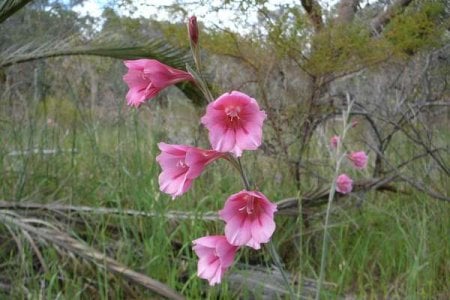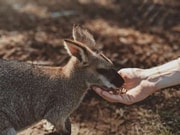Beware of Your Garden's Hidden Danger: Council Exposes Sinister Threat Lurking in This Common Flower
By
Seia Ibanez
- Replies 0
As the sun climbs higher and the scent of spring fills the air, our gardens become a canvas of color and life. It's a time when green thumbs and nature lovers alike rejoice in the resurgence of flora. However, amidst the blooming beauty, there lurks a hidden danger that could undermine the very essence of our native landscapes.
The City of Kwinana council has issued a stark warning to its residents about a seemingly innocent backyard flower that carries a sinister threat to Australian bushland. The culprit? The pink gladiolus plant, also known as gladiolus caryophyllaceus. While its vibrant pink petals may be a sight for sore eyes, this plant is an invasive species with the potential to wreak havoc on our delicate ecosystems.
Originally hailing from South Africa, the pink gladiolus has become an 'invasive garden escapee' in Australia. It's a term that might sound like something out of a botanical thriller, but it's a real concern for environmental conservationists. These plants, once confined to the cultivated corners of Aussie backyards, have broken free and are now spreading their roots across Western Australia's bushland.

The threat posed by the pink gladiolus is not to be underestimated. This plant is a formidable invader, capable of displacing native species and upsetting the balance of our unique ecosystems. The City of Kwinana's Mayor, Peter Feasey, has emphasized the severity of the situation, stating that the council may request residents to remove these plants if found in their gardens.
'I would not recommend planting pink gladiolus in your garden in Kwinana as this is one of the species listed on our Pest Plants local law, so you could be asked to remove them, and once they establish they can be very difficult to remove,' Mayor Feasey advised.
The pink gladiolus belongs to a group of plants known as 'geophytes', which grow from underground corms. These corms, along with seeds that are easily dispersed by the wind, allow the plant to propagate rapidly and spread throughout the landscape. The Banksia Woodland of the Swan Coastal Plain, a biodiversity hotspot, is particularly at risk from this invasive species.
To combat the spread of the pink gladiolus, the council has initiated 'Gladdy Grab' events. These community gatherings are a call to arms for locals to help protect the native bushland by removing the invasive plant. The events are not only a practical response to an environmental issue but also serve as a communal effort that brings people together for a common cause.
Mayor Feasey also offers a word of caution to those purchasing flowers from hardware stores. While the gladiolus bulbs sold there are 'generally' not the same as the invasive species, it's important to verify the species name on the nursery tag to ensure you're not inadvertently bringing home a garden foe.
The pink gladiolus blooms between August and October, but their beauty is fleeting as they 'die off quickly'. If you spot the distinctive pink flowers, the Mayor advises pulling them out carefully, including the underground corm, and disposing of them in your general waste bin. This action helps to prevent further spread and protects the surrounding bushland.
As we embrace the joys of spring and tend to our gardens, let's be mindful of the plants we nurture. It's our responsibility to safeguard our natural heritage for future generations. If you've encountered similar issues or have tips on managing invasive species in your garden, we'd love to hear from you in the comments below.

Do you have a story tip or experience with invasive plants in your garden? Share your insights with us at the Seniors Discount Club, and let's work together to preserve the natural beauty of our Australian landscapes.
The City of Kwinana council has issued a stark warning to its residents about a seemingly innocent backyard flower that carries a sinister threat to Australian bushland. The culprit? The pink gladiolus plant, also known as gladiolus caryophyllaceus. While its vibrant pink petals may be a sight for sore eyes, this plant is an invasive species with the potential to wreak havoc on our delicate ecosystems.
Originally hailing from South Africa, the pink gladiolus has become an 'invasive garden escapee' in Australia. It's a term that might sound like something out of a botanical thriller, but it's a real concern for environmental conservationists. These plants, once confined to the cultivated corners of Aussie backyards, have broken free and are now spreading their roots across Western Australia's bushland.

Do you have pink gladiolus at home? Beware, it might be dangerous! Credit: Urban Bushland Council WA
The threat posed by the pink gladiolus is not to be underestimated. This plant is a formidable invader, capable of displacing native species and upsetting the balance of our unique ecosystems. The City of Kwinana's Mayor, Peter Feasey, has emphasized the severity of the situation, stating that the council may request residents to remove these plants if found in their gardens.
'I would not recommend planting pink gladiolus in your garden in Kwinana as this is one of the species listed on our Pest Plants local law, so you could be asked to remove them, and once they establish they can be very difficult to remove,' Mayor Feasey advised.
The pink gladiolus belongs to a group of plants known as 'geophytes', which grow from underground corms. These corms, along with seeds that are easily dispersed by the wind, allow the plant to propagate rapidly and spread throughout the landscape. The Banksia Woodland of the Swan Coastal Plain, a biodiversity hotspot, is particularly at risk from this invasive species.
To combat the spread of the pink gladiolus, the council has initiated 'Gladdy Grab' events. These community gatherings are a call to arms for locals to help protect the native bushland by removing the invasive plant. The events are not only a practical response to an environmental issue but also serve as a communal effort that brings people together for a common cause.
Mayor Feasey also offers a word of caution to those purchasing flowers from hardware stores. While the gladiolus bulbs sold there are 'generally' not the same as the invasive species, it's important to verify the species name on the nursery tag to ensure you're not inadvertently bringing home a garden foe.
The pink gladiolus blooms between August and October, but their beauty is fleeting as they 'die off quickly'. If you spot the distinctive pink flowers, the Mayor advises pulling them out carefully, including the underground corm, and disposing of them in your general waste bin. This action helps to prevent further spread and protects the surrounding bushland.
As we embrace the joys of spring and tend to our gardens, let's be mindful of the plants we nurture. It's our responsibility to safeguard our natural heritage for future generations. If you've encountered similar issues or have tips on managing invasive species in your garden, we'd love to hear from you in the comments below.
Key Takeaways
- The City of Kwinana council is urging residents to remove the pink gladiolus plant from their gardens as it is an invasive species threatening native bushland.
- Pink gladiolus, or gladiolus caryophyllaceus, originates from South Africa and is considered an 'invasive garden escapee' that can displace native Australian species.
- Mayor Peter Feasey warns that these plants can be very difficult to remove once established and advises residents to check nursery tags when purchasing to avoid the invasive variety.
- The council organises 'Gladdy Grab' events to encourage community involvement in removing the invasive pink gladiolus to protect local ecosystems, particularly the Banksia Woodland of the Swan Coastal Plain.
Do you have a story tip or experience with invasive plants in your garden? Share your insights with us at the Seniors Discount Club, and let's work together to preserve the natural beauty of our Australian landscapes.







